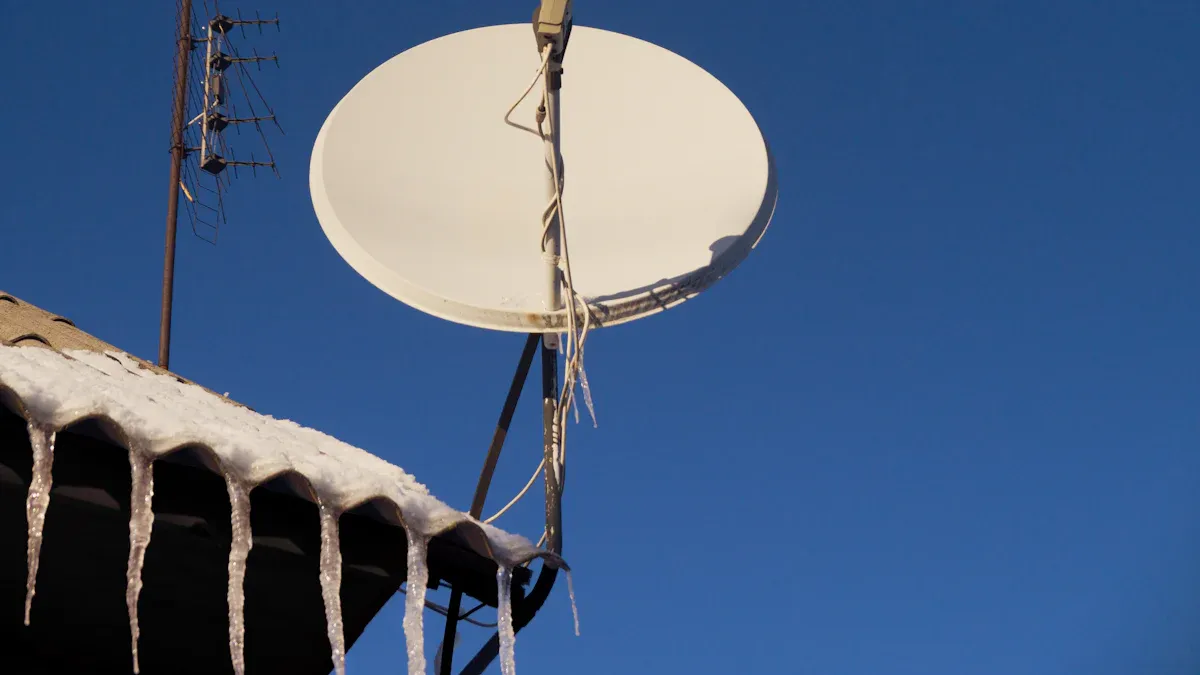How to keep your retail business running with offline satellite network management

Network outages can hurt any retail business. These problems can stop sales and upset customers. They can also hurt your store’s good name. Almost 38% of stores have big outages every week. When systems go down, stores lose a lot of money. Many stores lose more than $100,000 in just one hour. Some big stores lose up to $16,000 each minute when it is busy. Outages can happen for many reasons:
Impact on Retail Environment | |
|---|---|
Downtime during peak shopping periods | Stores lose money because sales cannot go through |
Manual network design errors | Stores pay more for help because of more problems |
Security risks due to outages | Customers get upset and trust the store less |
Disruptions in backend systems | Stores have slowdowns in work and deliveries |
Increased traffic levels leading to failures | Teams get less work done |
A strong satellite network can help your store stay open if other networks stop working. Check your backup plans now to make sure you are ready for the next outage.
Key Takeaways
A satellite network backup stops expensive downtime. It helps your store stay open when the internet goes out. This protects your sales and your store’s good name.
Train your staff often on what to do in emergencies. Well-prepared workers can act fast during outages. This keeps things running well and helps customers.
Test your backup systems often. Regular checks help you find problems early. This makes sure your store can bounce back fast from network issues.
Pick the best satellite solution for your store. Look at how much data you use and where you need coverage. This helps you choose a provider that fits your store’s needs.
Use strong security steps. Keep your data safe with encryption and access controls. This protects you from cyber threats during outages.
Why Retailers Need Satellite Network Backup

Preventing Costly Downtime
Every minute your store cannot make sales, you lose money. Downtime can cost up to $1.1 million each hour. If your main internet stops working, you might lose customers. Your store’s reputation can also get hurt. A satellite network gives you a backup. It keeps your business open when local networks fail.
Tip: Always make a backup plan for your network. This helps you avoid losing lots of money during outages.
A satellite network helps you:
Keep your registers and payment systems working.
Serve customers during storms or power outages.
Open new stores where regular internet does not work.
Satellite connections work well if fixed-line and cellular networks stop. They help you stay open and avoid slowdowns, even in faraway places.
Advantages Over Terrestrial Connections
A satellite network has benefits that other backups do not have.
Advantage | Description |
|---|---|
Infrastructure Independence | Satellite networks do not need local cables or towers, so they avoid shared problems. |
Flexibility in Deployment | You can set up satellite systems fast in many places, so they are good for new or temporary stores. |
Enhanced Reliability | Satellite networks keep your store online during outages, so you can keep selling. |
You also get:
Global coverage, which helps stores in faraway places.
Automatic failover, so your systems switch to satellite without stopping.
Reliable service during bad weather or disasters.
New satellite technology gives you faster speeds and lower delays than before. You can trust a satellite network to keep your retail business open, even if your main connection fails.
Setting Up Your Satellite Network Backup
Assessing Network Requirements
You need to know what your store needs before setting up a backup. Look at your systems and see how much data you use each day. Count how many devices connect to your network. Think about what jobs these devices do.
Hardware needs: Make sure you have the right routers, switches, and modems.
Bandwidth requirements: Figure out how much data your store uses when it is busy.
Latency concerns: Some things, like video calls, need quick response times.
Power requirements: Your backup system should use little power and not fail often.
Compliance: Follow the rules for your business.
Security: Keep hackers and data leaks away from your store.
Integration with existing systems: Your backup must work with your current setup.
Power and performance are important for every solution. When you use a satellite network for backup, reliability matters even more. Pick equipment that does not use much power and does not break often.
You also need to think about security. Every time you go online, there are risks. Cybercriminals look for weak spots. You must keep your store’s data safe and protect your network.
When you choose bandwidth, make sure your backup can handle your main jobs. If you use video calls or cloud storage, you need enough speed. Some things need low latency, so test your backup to see if it works well.
Choosing the Right Satellite Solution
There are many choices for satellite networks for your store. Look at what each provider gives you and see what matches your needs. Use the table below to compare important things:
Criteria | Description |
|---|---|
Data Intensity | Decide if your store uses a lot of data or just a little. Pick a service that fits your usage. |
Coverage | Check if the provider covers your area, especially if your store is in a remote place. |
Application Type | Think about whether your store is always in one place or moves around. |
Time Sensitivity | If you need real-time data, choose a network that can handle it. |
Some top providers, like Viasat, offer satellite internet for small businesses. They help stores in rural places and give professional installation and 24/7 support. Compare providers to see which one fits your store best.
Configuring Offline Management Tools
After you pick your satellite network, set up your backup tools. Follow these steps to keep your store online during an outage:
Router-Based Failover: Use a router that switches to your backup if your main internet fails. This keeps your store running without delay.
Load Balancers: Set up load balancers to watch your network traffic. They help share the load and make sure your backup works well.
SD-WAN: Use SD-WAN technology to reroute important data in real time. This helps your store stay fast, even when using a backup.
Tip: Test your backup system often. Make sure your staff knows what to do if the main network stops working.
A good setup lets your store switch to a satellite network quickly. You keep selling, help customers, and protect your data, even during an outage.
Data Redundancy and Recovery
It is very important to keep your data safe and easy to get back. This is just as important as keeping your store open. When you use a satellite network for backup, you need strong plans for data redundancy and recovery. These plans help you keep sales and customer trust during outages.
Backup Procedures and Commands
You need a simple backup plan to protect your business. Good backup steps help you get your data back fast if something goes wrong. Many stores use the 3-2-1 rule. This means you keep three copies of your data. You use two different types of storage. You keep one copy in a different place. This way, you are safer if one backup fails.
Backup Method | Description |
|---|---|
3-2-1 Rule | Keep three copies of data on two different types of storage, with one copy offsite to ensure redundancy and protection against data loss. |
Automated Integrity Checks | Use checksums and hashing to verify data integrity regularly, ensuring that backups are not corrupted. |
Recovery Testing | Regularly test backups to confirm that data can be restored successfully, which is crucial during network outages. |
Network redundancy is very important for business success. It uses extra systems or connections in a network. If one part fails, another part takes over. This helps stop downtime, which can cost money and time. This is very important for retail stores.
You should also use automatic tools to check your backups. These tools look for mistakes and keep your data safe. Testing your backups often helps you know they will work when you need them.
Failover systems are a key part of network redundancy. They switch to a backup system if the main one fails. This keeps things running during network problems.
Data Storage and Synchronization
If your main network stops working, you need to keep your data safe and up to date. There are many ways to protect your data and keep your store open:
Data Encryption: Use end-to-end encryption to keep your data safe. This protects your information if someone tries to steal it.
Access Controls: Give only trusted staff permission to see or change important data.
Device Management: Use remote wipe and auto data expiration for lost or stolen devices.
Audit Logging: Keep a record of all actions, both online and offline, to track changes and follow rules.
Data Minimization: Only store the most important information offline. This lowers the risk if a device is lost.
Redundancy helps save money and stops losses from interruptions. It lets you recover faster from problems. This helps your business keep working even if the main system fails.
You can also save data on local devices during an outage. This lets your store keep working and not lose updates. Track all changes made while offline. This helps you keep your data correct when you reconnect.
Local Data Storage: Save updates on local devices during outages.
Offline Tracking: Write down every change made while the network is down.
Conflict Resolution: Use rules like "last-write-wins" or ask staff to fix differences when syncing.
Error Handling: Set up retry systems to fix errors during synchronization.
Recovery After Outages
When your main network comes back, you need to get your data back fast. You may have some problems, but you can fix them with the right steps.
Challenge | Solution |
|---|---|
Scheduling backups regularly | |
Preventing data corruption | Make sure backups are safe and checked often. |
Aligning with your architecture | Make sure backup plans match your IT systems. |
Setting data backup priorities | Pick the most important data to recover first. |
Protecting against ransomware | Update security tools often to stop threats. |
You should always have a backup schedule. This keeps your data safe and ready to restore. Make sure your backup plan matches your store’s systems. Protect your data from threats like ransomware by updating your security tools often.
When you reconnect, use your backup steps to restore any missing data. Test your recovery process often. This helps you find problems before they hurt your business. If you follow these steps, your store can recover fast and keep helping customers, even after a network outage.
Ensuring Seamless Operations

Transaction Continuity
You need your store to keep working, even if the main network stops. A good plan helps you keep selling and helping customers. You can follow these steps to keep transactions going during an outage: Set up clear rules for handling cash. Make sure your team knows how to take cash and give change if card payments do not work. Train your staff to take payments by hand. They can use paper receipts or offline card readers if the system is down. Use backup ways to talk to your team. A satellite network helps you stay in touch and send updates, even if other networks are down.
Tip: Practice these steps with your team so everyone knows what to do if the network goes out.
Staff Training and Response
Your staff is very important when the network stops working. Give them training often on what to do during outages. Teach them how to switch to manual steps and use backup systems. Hold practice drills so they know what to do if the network fails. This helps your team stay calm and act quickly.
Tell your staff to report problems right away. Fast action can stop small problems from getting worse. Keep a simple checklist at each register or workstation. This helps staff remember what to do in an emergency.
Security Best Practices
You need to keep your store’s data safe, especially when using backup systems. Follow these best steps to protect your network: Split your network into parts. This helps stop damage if someone breaks in. Use strong data encryption for all information, both stored and sent. Check who can access your systems often. Watch for anything strange.
Work with other companies to share news about new threats.
Give your staff regular training on cybersecurity.
You can also use zero-trust security and keep important systems separate, like with air-gapping. Out-of-band traffic management gives extra safety, especially when you use satellite network solutions.
Note: Test your backup and security plans often. Practice helps you find weak spots before they cause problems.
Monitoring and Troubleshooting Your Satellite Network
Proactive Monitoring
You should always keep an eye on your satellite network. Watching it closely helps you find problems before they stop your store. Use network monitoring tools to check how fast your connection is. These tools also check signal strength and if your devices are healthy. Many tools will send you alerts if something is wrong. You can make dashboards to see your network’s status right away.
Use special software to see when your network is up or down.
Set alerts for weak signals or slow speeds.
Look at device logs to spot errors.
Tip: Check your network dashboard every morning. This helps you find problems early.
Troubleshooting Steps
If your satellite network has issues, you need to fix them quickly. Start by checking simple things first. Make sure all cables and devices are plugged in. Try restarting your router and modem. Look at your satellite dish to see if it is broken or blocked. Use the table below to help you fix common problems:
Problem | Quick Fix |
|---|---|
No connection | Restart router and modem |
Weak signal | Adjust satellite dish position |
Slow speeds | Check for device overload |
Error messages | Review device logs |
You can also use built-in tools to check for problems. Many routers have a "status" page that shows errors and connection details. If you still cannot fix it, call your provider for help.
Note: Keep a troubleshooting checklist near your network gear. This helps you act fast during outages.
Regular Testing and Updates
You need to test your backup system often. Plan regular practice drills to switch from your main network to satellite. Practice recovery steps with your team. Update your network software and firmware every month. This keeps your system safe and working well.
Run failover tests every few months.
Change passwords and check security settings.
Look at backup logs to find errors.
Checklist for Regular Testing:
1. Test failover switch
2. Check backup data integrity
3. Update device firmware
4. Review security settings
Regular testing helps you find weak spots before they cause trouble. Stay ready and keep your store open.
You can keep your retail business running by following these key steps:
Set up a reliable satellite backup network.
Train your staff for quick response.
Test your systems often to find weak spots.
Stay prepared. Review your backup plan regularly. Upgrade your tools when needed. This helps you avoid costly downtime and keeps your store open for customers.
FAQ
How does a satellite backup network help my store during an outage?
A satellite backup network keeps your store working. Your registers and payment systems stay online. You can keep selling things to customers. This works even if your main internet goes down.
What equipment do I need for satellite network backup?
You need a satellite dish and a modem that works with it. You also need a failover router. Some companies sell kits with everything you need. Ask your provider for a list of the right devices.
Can I process card payments if the main network fails?
Yes, you can use offline card readers or POS systems. These systems save sales when the network is down. When your network comes back, they upload the saved sales.
How often should I test my backup system?
You should test your backup system every few months. Testing often helps you find problems early. It also keeps your team ready for outages.
See Also
Starting a Low-Cost AI-Driven Convenience Store Business
Revolutionizing Online Retail Management with AI Tools
Enhancing Office Efficiency with Intelligent Vending Machines
